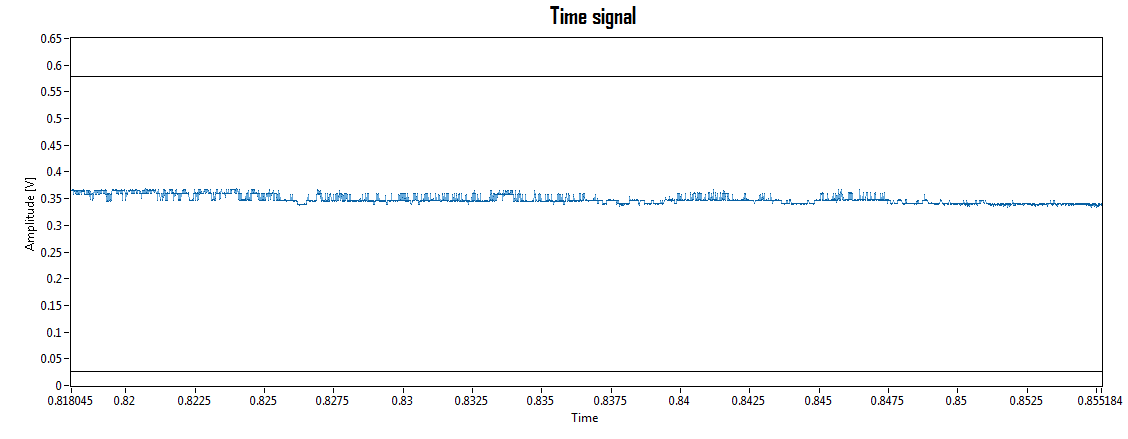I observed an unexpected signal while developing an interferometric sensor using a VCSEL laser. In order to debug this noise I designed the following device that converts minute changes in the laser's wavelength to large changes in optical intensity:
The 850 nm laser is biased above threshold using a low noise circuit (battery + resistor) and coupled to a fiber-based Mach-Zehnder interferometer that performs wavelength-to-intensity conversion, observable with a photodiode.
The voltage signal out of the photodiode looks like this:
 Depending on the wavelength of the laser, the average voltage can be anywhere between total constructive interference (0.57 V) and total destructive interference (0.02V). [This range is marked with horizontal bars in the plot above].
Depending on the wavelength of the laser, the average voltage can be anywhere between total constructive interference (0.57 V) and total destructive interference (0.02V). [This range is marked with horizontal bars in the plot above].
The interesting observation appears when we zoom-in the signal:

We can observe discrete jumps in the photodiode's voltage, corresponding to discrete jumps in the lasing wavelength. Knowing the distance difference in the two arms of the interferometer $\Delta L =$ 34 mm and the voltage range in the output $V_{pp} =$ 0.55 V it is possible to convert voltage noise to wavelength (or wavenumber $k=2\pi / \lambda$) as
$$ \delta k = \frac{2}{V_{pp} \Delta L} \delta V \simeq 107 \frac{\mathrm{m^{-1}}}{\mathrm{V}} \delta V.$$
We can then infer that the central jumps represent a wavelength jump below 0.12 pm or 51 MHz
Now the question is: What can be causing such minute but discrete wavelength jumps in a laser with supposedly no mode jumps? Is it a fundamental, quantum effect?
Please note that my knowledge in solid state physics is quite limited, so maybe I am missing something out here. Any pointers on the possible source of such jumps or which experiments I can perform to narrow down their origin would be heavily appreciated!
Some observations (to the best of my knowledge):
- The jumps are NOT caused by quantization of the ADC or photodiode.
- VCSEL lasers are not supposed to have longitudinal mode jumps.
- We observe a similar signal using a different VCSEL laser from different manufacturer.
- We don't observe such a signal when using a DFB laser.
- When the interferometer works at either total constructive or total destructive interference, the jumps in the signal are no longer visible, pointing out that the jumps are predominantly in wavelength and not in intensity.
- We nevertheless observe a similar (but much, much smaller) signal if we measure the output power of the laser directly with a photodiode.
- The power spectral density of the observed noise is ~1/f and with no peaks.
UPDATE:
The VCSEL is fiber coupled by factory into a single-mode fiber. Thus we are only observing the TEM00 transverse mode. Given that the intensity fluctuations are below -140 dB, I am assuming that no power is going to higher order modes.
The hops depicted above happen at multiple biasing points and far away from the maximum driving current. Furthermore, there are more than two wavelengths where the VCSEL locks. That would speak against polarization hops (?)
Using an isolator between the fiber-coupled VCSEL and the laser did not solve the problem

